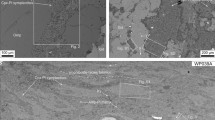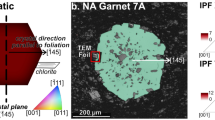Abstract
Antigorite forms a polysomatic series of discrete compositions that are chemographically colinear with chrysotile/lizardite, Mg3Si2O5(OH)4 and talc, Mg3Si4O10(OH)2. The compositional variations of antigorite correspond to discrete changes in the lattice parameter, a. A complete suite of antigorites, collected from a cross-section representing increasing metamorphic grade through the Swiss and Italian Alps, has been studied by optical and transmission electron microscopy (TEM). The specimens within this suite range from those formed near the lower stability limit of antigorite (250 °C) through to those formed near its breakdown temperature (550 °C). The lower grade samples belong to the regionally metamorphosed upper Pennine Ophiolites of the Oberhalbstein-Malenco area, while higher grade antigorites were obtained from regionally metamorphosed Malenco serpentinites. The highest grade samples are also from Malenco. They underwent a later contact metamorphism within the thermal aureole of the Bregaglia Intrusive. The lattice parameter a of antigorites evolves from longer (60 Å) to shorter (35 Å) values with increasing metamorphic grade. However, individual antigorites almost invariably show a heterogeneous distribution of a periodicities with higher values close to grain boundaries or reaction fronts and lower values towards the grain centers. The crystal-chemical evolution of antigorite, expressed by reduction in a, is usually accompanied by increased crystallinity. With the TEM, this is seen as an increase in crystallite size and a decrease in the number of crystal defects (twinning, polysomatic disorder, modulation dislocations, wobbling, offset). The structural and compositional evolution of antigorite requires intracrystalline diffusion and reconstructive transformations at relatively low temperatures. Therefore, the process of evolution is sluggish. Equilibrium is frequently not attained, and relics of longer a periodicities can be observed. In addition, relics of chrysotile may be observed in high-grade metamorphic rocks of the Malenco area, in which antigorite coexists with new-formed olivine. Only at one locality is there evidence of “equilibrium”: antigorite formed at 435 °C has a=43 Å; it shows very little variation in the a periodicity, and it is characterized by a homogeneous annealing texture. A geothermometer based upon a periodicities, as proposed by Kunze (1961) has limited practical applicability.
Similar content being viewed by others
References
Aruja E (1944) An X-ray study of the crystal structure of antigorite. Mineral Mag 27:65–74
Buseck PR (1984) Imaging of minerals with the TEM. EMSA Bull 14:47–49
Buseck PR, Cowley JM (1983) Modulated and intergrowth structures in minerals and electron microscope methods for their study. Am Mineral 68:18–40
Cornelius HP (1912) Petrographische Untersuchungen in den Bergen zwischen Septimer- und Julierpass. Neues Jahrb Mineral 35:374–498
Dietrich V, Peters T (1971) Regionale Verteilung der Mg-Phyllosilikate in den Serpentiniten des Oberhalbsteins. Schweiz Mineral Petrogr Mitt 51:329–348
Engi M, Lindsley DH (1980) Stability of titanian clinohumite: experiments and thermodynamic analysis. Contrib Mineral Petrol 72:415–424
Evans BW, Trommsdorff V (1970) Regional metamorphism of ultramafic rocks in the Central Alps: Parageneses in the system CaO-MgO-SiO2-H2O. Schweiz Mineral Petrogr Mitt 50:481–492
Evans BW, Johannes W, Oterdoom H, Trommsdorff V (1976) Stability of chrysotile and antigorite in the serpentinite multisystem. Schweiz Mineral Petrogr Mitt 56:79–93
Ferraris G, Mellini M, Merlino S (1986) Polysomatism and the classification of minerals. Rend Soc Ital Mineral Petrol 41:181–192
Frost BR (1975) Contact metamorphism of serpentinite, chloritic blackwall and rodingite at Paddy-Go-Easy-Pass. Central Cascades, Washington. J Petrol 16:272–313
Goldsmith JR, Newton RC (1969) P-T-X relations in the system CaCO3-MgCO3 at high temperatures and pressures. Am J Sci 267-A, 160–190
Hemley JJ, Montoya JW, Christ CL, Hostetler PB (1977) Mineral equilibria in the MgO-SiO2-H2O system. I. Talc-chrysotile-brucite stability relations. Am J Sci 277:322–351
Iishi K, Sato M (1973) Synthesis of antigorite. Am Mineral 58:915–919
Johannes W (1975) Zur Synthese und thermischen Stabilität von Antigorit. Fortschr Mineral 53:36
Kündig R (1982) Geologie und Petrographie der Bernina: V.: Furtschellas (Ultrabasica). Diplomarbeit, ETH Zürich
Kunze G (1961) Antigorit. Strukturtheoretische Grundlagen und ihre praktische Bedeutung für die weitere Serpentin-Forschung. Fortschr Mineral 39:206–324
Livi KJT, Veblen DR (1987) “Eastonite” from Easton, Pennsylvania: a mixture of phlogopite and a new form of serpentine. Am Mineral 72:113–125
Matthes S (1971) Die ultramafischen Hornfelse, insbesondere ihre Phasenpetrologie. Fortschr Mineral 48:109–127
Mellini M (1982) The crystal structure of lizardite 1T: hydrogen bonds and polytypism. Am Mineral 67:587–598
Mellini M (1986) Chrysotile and polygonal serpentine from the Balangero serpentinite. Mineral Mag 50:301–306
Mellini M, Zanazzi PF (1987) The crystal structure of lizardite 1T and 2H1 from Coli, Italy. Am Mineral (in press)
Mellini M, Zussman J (1986) Carlosturanite (not “picrolite”) from Taberg, Sweden. Mineral Mag 50:675–679
Oterdoom WH (1978) Tremolite- and diopside-bearing serpentine assemblages in the CaO-MgO-SiO2-H2O multisystem. Schweiz Mineral Petrogr Mitt 58:127–138
Rice JM (1977) Progressive metamorphism of impure limestone in the Marysville aureole, Montana. Am J Sci 276:1–24
Spinnler GE (1985) HRTEM study of antigorite, pyroxene-serpentine reactions, and chlorite. Ph D dissertation, Arizona State University
Spinnler GE, Veblen DR, Buseck PR (1982) Complexities in antigorite modulations. Geol Soc Am Abstr Prog 14:623
Spinnler GE, Veblen DR, Buseck PR (1983) Microstructure and defects of antigorite. Proc 41st Ann Meet Electron Microsc Soc Am San Francisco Press, San Francisco, pp 190–191
Thompson JB Jr (1978) Biopyriboles and polysomatic series. Am Mineral 63:239–249
Trommsdorff V (1983) Metamorphose magnesiumreicher Gesteine: Kritischer Vergleich von Natur, Experiment und thermodynamischer Datenbasis. Fortschr Mineral 61:283–308
Trommsdorff V, Evans BW (1972) Progressive metamorphism of antigorite schist in the Bergell tonalite aureole (Italy). Am J Sci 272:423–437
Trommsdorff V, Evans BW (1974) Alpine metamorphism of peridotitic rocks. Schweiz Mineral Petrogr Mitt 46:431–460
Trommsdorff V, Evans BW (1977) Antigorite-ophicarbonates: contact metamorphism in Valmalenco, Italy. Contrib Mineral Petrol 62:301–312
Trommsdorff V, Evans BW (1980) Titanian hydroxyl-clinohumite: formation and breakdown in antigorite rocks (Malenco, Italy). Contrib Mineral Petrol 72:229–242
Uehara S, Shirozu H (1985) Variations in chemical composition and structural properties of antigorites. Mineral J 12:299–318
Vance JA, Dungan MA (1977) Formation of peridotites by deserpentinization in the Darrington and Sultan areas. Cascade Mountains, Washington. Geol Soc Am Bull 88:1497–1508
Veblen DR (1980) Anthophyllite asbestos: microstructures, intergrown sheet silicates, and mechanism of fiber formation. Am Mineral 65:1075–1086
Veblen DR, Buseck PR (1979) Serpentine minerals: intergrowths and new combination structures. Science 206:1398–1400
Whittaker EJW, Wicks FJ (1970) Chemical differences among the serpentine “polymorphs”: a discussion. Am Mineral 55:1025–1047
Wicks FJ, Whittaker EJW (1975) A reappraisal of the structures of the serpentine minerals. Can Mineral 13:227–243
Yada K (1979) Microstructures of chrysotile and antigorite by high-resolution electron microscopy. Can Mineral 17:679–691
Zussman J (1954) Investigation of the crystal structure of antigorite. Mineral Mag 30:498–512
Zussman J, Brindley GW, Comer JJ (1957) Electron diffraction studies of serpentine minerals. Am Mineral 42:133–153
Author information
Authors and Affiliations
Rights and permissions
About this article
Cite this article
Mellini, M., Trommsdorff, V. & Compagnoni, R. Antigorite polysomatism: behaviour during progressive metamorphism. Contr. Mineral. and Petrol. 97, 147–155 (1987). https://doi.org/10.1007/BF00371235
Received:
Accepted:
Issue Date:
DOI: https://doi.org/10.1007/BF00371235




